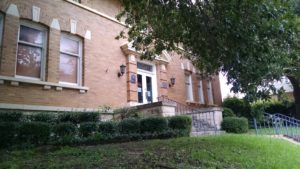Carnegie Libraries
 Our Carnegie Library, like 1,679 other Carnegie Libraries across the United States, is named after Andrew Carnegie. Carnegie emigrated from Scotland to America at the age of 13 and eventually became one of the wealthiest individuals of his time, amassing his fortune in the steel industry. Recognizing that education was the foundation of his success, Carnegie sought to provide others with the same opportunities he had experienced.
Our Carnegie Library, like 1,679 other Carnegie Libraries across the United States, is named after Andrew Carnegie. Carnegie emigrated from Scotland to America at the age of 13 and eventually became one of the wealthiest individuals of his time, amassing his fortune in the steel industry. Recognizing that education was the foundation of his success, Carnegie sought to provide others with the same opportunities he had experienced.
In total, Carnegie funded the construction of over 2,500 libraries, and our library proudly counts itself among them. While he was very generous in his philanthropic efforts, Carnegie was also a businessman at heart. As a result, he imposed certain conditions that needed to be met before he would agree to build a library.
To establish a successful library, two essential criteria must be fulfilled:
1. The land designated for the library must be fully owned, ensuring there are no future complications regarding ownership.
2. Robust measures must be implemented to guarantee the library’s financial stability for years to come.
Given these requirements, it’s no surprise that his Free Library Application included inquiries about taxes, expenditures, and related issues.
Tyler's First Library
Tyler’s Carnegie Library, a charming architectural treasure built in 1904, served the community until 1980, when a new library opened across the street. This historic building is rich with stories:
- It was the first in downtown Tyler to have running water, and visitors can still see the quaint washroom that once served patrons.
- During World War I, the local Red Cross operated from the public meeting space on the second floor, where countless bandages were rolled, and supplies were sent from home, creating a powerful atmosphere of dedication and pride.
- In 1979, this beloved library was added to the National Register of Historic Places. Inside, you can find a striking mural painted in 1934 by artist Douthitt Wilson, part of the Public Works of Art Program, which remains rare for its originality at this location.
- Since the mid-1980s, the Smith County Historical Society has proudly occupied this significant site, dedicated to preserving and celebrating our local history.
Examine the influence of Andrew Carnegie and his visionary Free Library Program. Discover how his dedication to knowledge and community transformed access to education. Check out this detailed page for more insights!
